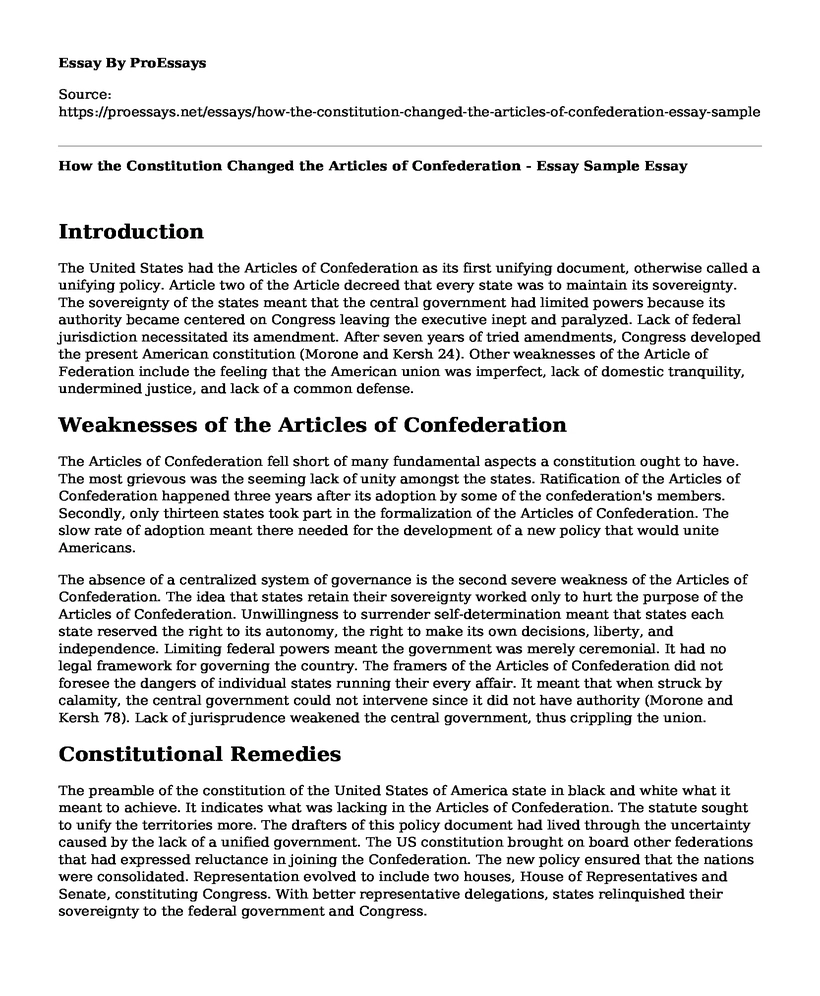Introduction
The United States had the Articles of Confederation as its first unifying document, otherwise called a unifying policy. Article two of the Article decreed that every state was to maintain its sovereignty. The sovereignty of the states meant that the central government had limited powers because its authority became centered on Congress leaving the executive inept and paralyzed. Lack of federal jurisdiction necessitated its amendment. After seven years of tried amendments, Congress developed the present American constitution (Morone and Kersh 24). Other weaknesses of the Article of Federation include the feeling that the American union was imperfect, lack of domestic tranquility, undermined justice, and lack of a common defense.
Weaknesses of the Articles of Confederation
The Articles of Confederation fell short of many fundamental aspects a constitution ought to have. The most grievous was the seeming lack of unity amongst the states. Ratification of the Articles of Confederation happened three years after its adoption by some of the confederation's members. Secondly, only thirteen states took part in the formalization of the Articles of Confederation. The slow rate of adoption meant there needed for the development of a new policy that would unite Americans.
The absence of a centralized system of governance is the second severe weakness of the Articles of Confederation. The idea that states retain their sovereignty worked only to hurt the purpose of the Articles of Confederation. Unwillingness to surrender self-determination meant that states each state reserved the right to its autonomy, the right to make its own decisions, liberty, and independence. Limiting federal powers meant the government was merely ceremonial. It had no legal framework for governing the country. The framers of the Articles of Confederation did not foresee the dangers of individual states running their every affair. It meant that when struck by calamity, the central government could not intervene since it did not have authority (Morone and Kersh 78). Lack of jurisprudence weakened the central government, thus crippling the union.
Constitutional Remedies
The preamble of the constitution of the United States of America state in black and white what it meant to achieve. It indicates what was lacking in the Articles of Confederation. The statute sought to unify the territories more. The drafters of this policy document had lived through the uncertainty caused by the lack of a unified government. The US constitution brought on board other federations that had expressed reluctance in joining the Confederation. The new policy ensured that the nations were consolidated. Representation evolved to include two houses, House of Representatives and Senate, constituting Congress. With better representative delegations, states relinquished their sovereignty to the federal government and Congress.
The strengthening of the federal government brought with it a sense of security. Defense of the States in the hands of the central government meant better defense resources as well as increased funding. Congress also benefited from the constitution because whatever laws it passed, the federal government would enforce, contrary to the previous situation when there was no enforcing agency (Morone and Kersh 122). The presence of a federal government meant better legislation on taxes as well as revenue allocation. A sense of order came with the constitution. Institutions began working efficiently with proper funding from Congress through the federal government. The spirit in the Articles of Confederation defeated justice in that, amendment of any article required a unanimous vote. Now, we need the majority vote to legislate any law.
Conclusion
The Articles of Confederation, as well as the Constitution, have a lot in common. The same people developed both blueprints. Their differences would suggest otherwise. It is hard to imagine the same people, would develop two documents with that much contrast. While the spirit behind their drafting might have been the same, their framing is miles apart. The constitution is not merely an amendment of the Articles of Confederation. It is a complete overhaul.
Works Cited
Morone, James A., and Rogan Kersh. By the people: Debating American government. Oxford University Press, 2016.
Cite this page
How the Constitution Changed the Articles of Confederation - Essay Sample. (2022, Nov 22). Retrieved from https://proessays.net/essays/how-the-constitution-changed-the-articles-of-confederation-essay-sample
If you are the original author of this essay and no longer wish to have it published on the ProEssays website, please click below to request its removal:
- Political Science Essay: The Concept of Democracy
- Research Paper on Comparison of the 2000 And 2004 Democratic National Convention Security Plan
- Regulation and Deregulation and Its Impact on Intermodal Transport - Essay Sample
- Effects of the Constitution on Homeland Security Essay Example
- Race & Gender: Two Factors in Governmental Inequality - Research Paper
- Essay on the Fight Against America's Drug Problem: The Role of Villages & Police
- Essay Example on Nationalism: A Political and Emotional Expression of Identity.







